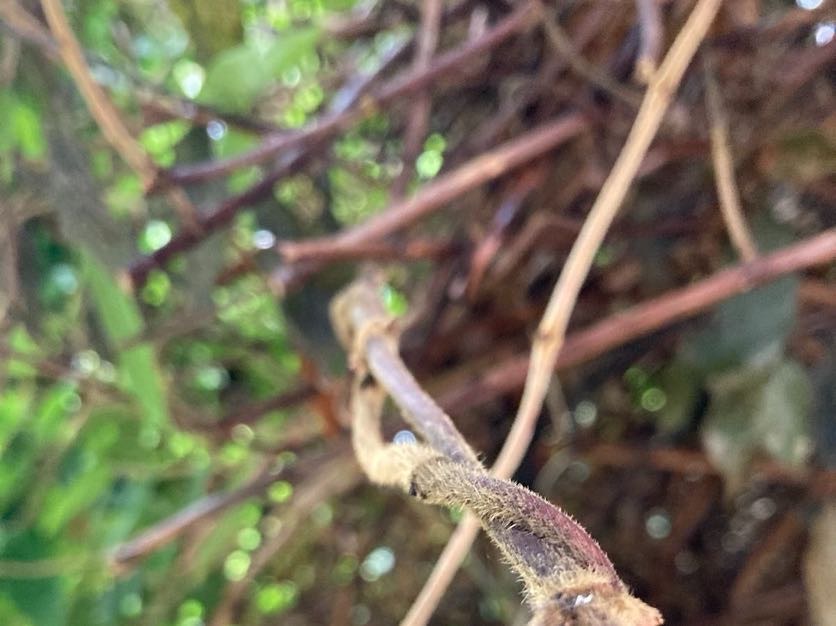Sleeps, Creeps, Leaps
26 January 2024

At -3°C the garden is an unfamiliar place today. Stark, white and crisping underfoot, it seems wider somehow and flatter, shrunken back in on itself. The pond is frozen, but cracks quickly enough when I test it with my foot. The foxgloves have wilted, but the Avens (Geum) looks merely dusted with sugar. The Miscanthus is impervious, as straight as ever and utterly unaffected. Unlike the Japanese honeysuckle.
Lonicera japonica, with pretty yellow flowers and rapid evergreen growth, is a horticultural purchase I have regretted for a decade. In sub-zero temperatures its leathery, lanceolate leaves shrivel so much they become almost subulate; awl-shaped, tapering to a point. They take on a much darker hue, a survival response to concentrate the chlorophyl. They look brittle, but they’re not, of course. By midday, when the temperature has risen to 1°C, the leaves will expand back into their usual thuggish selves.
The realisation that we have filled our gardens with invasive species seems to be in evidence everywhere. We’ve been doing it for millennia, but the process sped up after we all started getting in our cars and going to the garden centre, about fifty years ago.
‘Look at that awful plant’, someone said to me at the New Year Plant Hunt, an event organised by botanical societies across the UK as part of the BSBI’s efforts to track what is going on with our flora.
The plant was Green alkanet (Pentaglottis sempervirens - native of southwest Europe), with little blue flowers just like Forget-me-not. As a garden plant, it has its appeal – it will grow in dark dank places, has a long flowering season, is popular with pollinators – but it has been seeding itself across the country since the 18th Century, has a very long taproot and is extremely difficult to eradicate. 1
‘Look at that awful plant’, someone else said to me three months earlier. It was mid-October, and I was being shown around the gardens of a local college. We’d got as far as the lake and I couldn’t see anything problematic – just some reeds and a Gunnera (Gunnera manicata - native of Brazil and Chile).
‘That plant, the giant rhubarb’, my guide gesticulated.
‘Oh’, I said, ‘I think it’s just a Gunnera’, and briefly reminisced happy days taking my children around botanical gardens about twenty years ago, and standing by vast clusters of palmate lobed leaves, each about two metres wide.
‘It’s terrible, we’ve got to get rid of it …’ I nodded sympathetically but remained confused. Until I discovered in December that it’s now banned in the UK for smothering native flora and invading waterways. 2 It turns out Gunnera manicata - introduced in the 19th Century - quickly crossed with Gunnera tinctoria to become the super-spreader Gunnera × cryptica.
Green alkanet, Gunnera, and many others, none of these plants are really ‘awful’, but they are often the wrong plant in the wrong place. The results of the BSBI New Year Plant Hunt reveal that 326 out of the 629 species identified are non-native. 3 The scales have tipped their way, and what this means for our native flora is not yet clear.
Back in my garden, three hours after my own awful plant looked about to peg it, its leaves have spread out, turning their best sides towards the thin January sun. Like ivy (which is a native), Japanese honeysuckle is a plant that sleeps, creeps and leaps.
The ice melts. The foxgloves revive. The honeysuckle stems twist and twine, reaching out in their determined colonisation of every available structure.
1 Jane Perrone (2022) ‘Green alkanet – that mystery plant revealed’. Available at: https://www.janeperrone.com/blog/greenalkanet (Accessed 21st January 2024).
2 Horton, H. (2023) ‘UK bans giant rhubarb after study finds popular garden plant is invasive’, The Guardian, 8th December. Available at: https://www.theguardian.com/environment/2023/dec/08/uk-bans-popular-garden-plant-gunnera-after-study-finds-it-an-invasive-species (Accessed 21st January 2024).
3 BSBI (2024) ‘BSBI New Year Plant Hunt 2024’. Available at: https://bsbi.org/wp-content/uploads/dlm_uploads/2024/01/BSBI-New-Year-Plant-Hunt-2024-Report-.pdf. (Accessed 24th January 2024).
